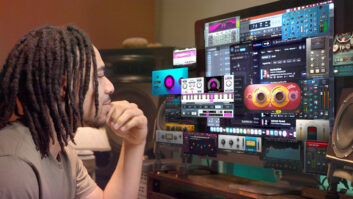Jack Joseph Puig at the Waves, Blue Mics
and Esquire event in L.A. regaled attendees with session stories and insights into the JJP Artist Signature line of Waves plug-ins.LOS ANGELES, CA—On December 8, 2010, Waves, Blue Microphones and Esquire magazine co-sponsored a presentation of the software maker’s Jack Joseph Puig Artist Signature Collection in the recording studio of the Esquire House. Perched high above L.A.’s Sunset Strip, the showcase residence, billed as “the ultimate bachelor pad” by Esquire, provided a suitably dramatic setting for the high-profile producer/ engineer as he discussed his latest creation and put it through its paces.

An in-demand mixer for nearly two decades, Puig has accumulated a truly impressive array of gear, which is on display— and in regular use—in Ocean Way’s Studio D, where he works a minimum of six days a week, while also acting as a gregarious host for a constant stream of clients. Since connecting with Waves in 2004, Puig has made use of his extensive knowledge of hardware and its uses to develop, in partnership with the company’s designers, the JJP Signature Series—digital versions of iconic analog pieces, pimped out with retro graphics. The series launched in 2008 with the Fairchild 660 and 670 compressors and the Pultec EQP- 1A and MEQ-5 equalizers, whose unique sonic characters were re-created in the form of the amusingly named PuigChild and PuigTec EQP1- A, and MEQ-5. It continues with the recently released JJP Artist Collection, which bundles 25 separate plug-ins, retailing for $880.
The afternoon event began with one of Puig’s signature (no pun intended) spiels, alternately drawing nods of approval and belly laughs from the proaudio mavens crammed into the control room, as he illuminated the philosophy behind the plug-in series with anecdotes about Quincy Jones and Jerry Moss, acknowledgments of his Waves partners (“Nobody writes software better than the Israelis”), his mentors and the audio pioneers whose empirical/intuitive methodology he’s bent on perpetuating. Puig peppered his 35-minute monologue with out-there analogies and seeming digressions that always somehow returned to the point, like a Jerry Garcia solo in a Grateful Dead marathon concert. The point being that the Signature Collection was created through “a marriage of science and soul” (he credited Quincy with coining the term). This yin/ yang principle enables the practitioner to make decisions in the recording studio “not about highs, lows, midrange or EQ or treble or compression or reverb, but about what we call ‘the X Factor.’”
Explaining that he designed the bundle with the self-recording, aspiring artist in mind, Puig stated, “This is a plugin that has a few decades of love, life, sweat, sweat, energy, failing, winning, shit record, hit record, etc. I wanted all of that to be built into the plug-in, so that these guys, when they’re writing and working, they can just turn it on and go, ‘This is great. I don’t need to worry about the science; this is really hot. I’m staying in my creative space/ soul. They’ve got everything they need to create their song…This is not a matter of regurgitation. It’s a future product where the guy I described has the ability to go back to what matters—to write classic songs and make classic records.”
The usefulness of the collection, which took eight months to design, isn’t limited to home recording, however. Puig assured everyone that he uses it “all the time” on his mix projects, and estimating that it gets the job done more than 90 percent of the time. The processing results in “a 3-D sort of experience,” he offered. “Magic—that’s what you get.”
Screen shot of JJP Artist Signature line of Waves plug-insPuig then started the demo, pointing out that what we’d be hearing would be run through the standard, out-ofthe- box preset of the collection’s vocal processor. An engineer seated in front of the SSL Duality SE board then toggled between the original recordings of iso’d vocals by Mick Jagger, Bono, John Mayer, Fergie and Keith Urban and the processed treatments. In each case, the difference was dramatic in terms of both presence and subtlety. Following the Mayer sampling, Puig enthused, “I feel him—the air, the attitude.” While he may have been hyping the product, his words served as an accurate assessment of the qualities the plug-in brought out. The contrast between the original and enhanced vocals was readily apparent even listening back on the handheld Philips digital recorder I’d used to capture the producer’s discussion.

For the climax of his presentation, Puig had the engineer A/B Keith Urban’s 2009 hit single, “Kiss A Girl,” in its original form and using the bass, drums, guitar and vocal plug-ins. One of the attendees offered a succinct description of what he experienced whenever the engineer hit the button to cue the processing: “Ka-POW.”
But according to Puig, we ain’t seen— or heard—nothin’ yet. “This is a Model T Ford compared to what it’s gonna be two years from now,” he promised.
Waves
waves.com






